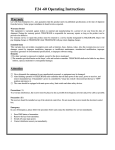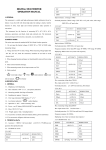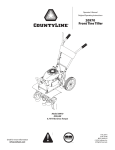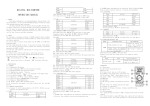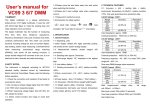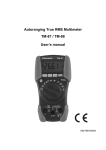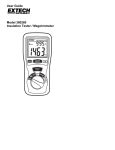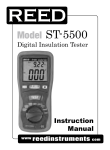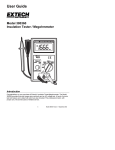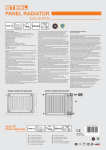Download Victor 88A User manual
Transcript
DIGITAL MULTIMETER OPERATION MANUAL 1. SUMMARIZE The instrument is a steady performance, battery-driven digital multimeter.It uses the LCD with 30mm-high figure to make the reading clear. The function of 15 sec. backlight displaying and overload protection make operation more convenient. The instrument has the function of measuring DCV, ACV, DCA, ACA, resistance, capacitance, test,temperature and frequency, anddiode,triode and continuity test. The instrument takes dual-integral A/D converter as key point, is an excellent tool. 2. SAFETY NOTE This series meter's design meets the article of IEC1010 (security stan dard enacted by IEC). Please read the following before operation. 1 Do not input a limited voltage higher than DC 1000V or AC 750Vwhen measuring ranges. 2 Voltage less than 36V is a safety voltage. When measuring voltage higher than DC 36V, AC 25V, check the connection and insulation of test leads to avoid electric shock. 3 Be sure to keep the test leads off the testing points when con verting function and range. 4 Select correct function and range to avoid fault operation. 5 When measuring current, do not input current over 20A. 6 Safety symbols exists high voltage GND dual insulation must refer to manual low battery 3. CHARACTERISTIC 1 GENERAL 1-1 Displaying: LCD displaying, 1-2 Max. indication: 1999 3 1/2 , auto polarity indication, 1-3 Measuring method: dual slope A/D transfer, 1-4 Sampling rate: approx. 3 times/sec 1-5 Over range indication: MSD displays 1 or -1 , 1-6 Low battery indication: symbol displays, 1-7 Operation: (0 40) relative humidity <80%, 1-8 Power one 9V battery (NEDA1604/6F22 or equivalent 1-9 Size: 189 97 35 mm (length width height) 1-10 Weight: approx.375g (including a battery) 1-11 Accessories: test leads, user manual, holster, gift box, and 9v battery. 1-12. testing accessories: a pair of alligator clip, a test accessory for Triode,banana-type hot thermocouple.. 2 TECHNICAL CHARACTERISTIC 2-1 Accuracy: (a% rdg d) at (23 5) R.H.<75% one year guaranteed from the production date. 2-2 TECHNICAL DATA 2-2-1.DC VOLT (DCV) Range Resolution Accuracy 200mV 2V 100uV (0.5%+3) 20V 1mV 10mV 200V 100mV (1.0%+5) 1000V 1V Input resistance: 10M . Overload protection: 200mV range: 250V DC or AC peak value. Other range: 1000V DC or AC peak value. 2-2-2. AC VOLT (ACV) Range Resolution Accuracy 2V 20V 1mV (0.8%+5) 10mV 200V 100mV (1.2%+5) 750V 1V Input resistance: 10M . Overload protection: 1000V DC or AC peak value. Frequency response: less than 200Vrange: 40 400 Hz 750V range: 40 200 Hz. Displaying: sine wave rms(mean value response). 2-2-3.DC CURRENT(DCA) Range Resolution Accuracy 20uA 200uA 0.01uA (0.8%+4) 20mA 0.1uA 10uA 200mA (1.2%+4) 2A (1.5%+5) 100uA 1mA (2.0%+5) 20A 10mA Max. input volt drop: 200mV Max. input current: 20A the test time should be in 10 seconds Overload protection: 2A/250V quick-action fuse, 20A un-fused 1 2-2-4. AC CURRENT(ACA) Accuracy Resolution 200mA (2.0%+5) 100uA 2A (3.0%+5) 1mA Range (3.0%+10) 10mA 20A Max. measuring volt drop: 200mV Max. input current: 20A the test time should be in 10 seconds Overload protection: 2A/250V quick-action fuse, 20A un-fused Frequency response: (40 200)Hz Display: sine wave RMS (mean value response) 2-2-5. RESISTANCE( ) Resolution Accuracy Range 200 (0.8%+5) 0.1 1 2k 20k 10 (0.8%+3) 100 200k 1k [5.0%(RDG-10)+20] 100 k 200M Open voltage: less than 3V Overload protection: 250V DC and AC peak value NOTE: A.at 200 range, should make the test leads short, and measure the wire resistance, then, subtract from the actual measuring. B.at 200M range, should make the test leads short, the meter will display 1.0 M . It's normal and has no effect on the accuracy. Should be subtracted from actual measuring. 2-2-6. CAPACITANCE(C) 2M Range Resolution Accuracy 10pF 20nF 2uF 1nF (2.5%+20) 100nF 200uF Overload protection: 36V DC or AC peak value. 2-2-7. DIODE AND CONTINUITY TEST Range Displaying Test condition The positive DC current is Positive voltage drop of approx. 1mA negative voltage is approx. 3V diode Buzzer sounds , the resistaopen voltage is approx. 3V nce is less than (70 20) Overload protection: 250V DC or AC peak value Warning: DO NOT input any voltage at this range for safety! 2-2-8. TRANSISTOR hFE DATA TEST Range Displaying Test condition hFE NPN or PNP 0 ~ 1000 2-2-9.HOT WIRE TEST Range Displaying Alarming Way Basic current is approx. 10uA Vce is about 3V condition TEST 000or1 sound, light Standard AC hot wire test Overload protection DC 500V or AC peak value CAUTION BE CAREFUL WHEN YOU OPERATE IT. 4. OPERATION 4-1 Panel description (SEE THE FIG). 1 LCD: display the measuring value 2-1 POWER switch: turn on/off the power. 2-2 B/L switch: turn on/off the back light. AUTO POWER OFF 2-3 HOLD key: press it, the max. of presently measured value is held on LCD and HOLD symbol displays. Press it again, HOLD symbol disappears, and the meter is exited the holding mode. 2-4.The light of hot wire testing, 3 Range knob: to select measuring function and range. 4 Voltage, resistance and frequency COM 5 GND, the anode COM of test accessory, 6 2A current test COM, the cathode COM of test accessory, 7 COM for measuring current 20A 4-2 DCV measurement 1. Apply the black test lead to COM terminal and the red one to V/ terminal. 2. Set the knob to a proper DCV range , and connect the leads crossly to the electric circuit under test, LCD displays polarity and voltage under test connected by the red test lead. Note 1. Firstly users should set the knob to the highest range, if users had no idea about the range of voltage under test, and then select the proper range based on displaying value. 2. If LCD displays 1 , it means meter is over the max. Value of range, thus should set the knob to a higher range. 3. Do not input a voltage over DC 1000V. 4. Be carefully while measuring a high voltage. DO NOT touch the circuit. 4-3. ACV measurement 1. Apply the black test lead to COM terminal and the red one to V/ terminal. 2 Set the knob to a proper ACV range, and then connect the leads crossly to the electric circuit under test. NOTE: 1. Firstly users should set the knob to the highest range, if users had no idea about the range of voltage under test, and then select the proper range based on displaying value. 2. If LCD displays 1 , it means meter is over the max. value of range, thus should set the knob to a higher range. 3. Do not input a voltage over 750Vrms. 4.Be carefully while measuring a high voltage. DO NOT touch the circuit. 4-4. DCA Measurement 1. Apply the black test lead to COM terminal and the red one to mA terminal (the Max. 2A) or to 20A (the Max.20A); 2. Set the knob to a proper DCA range, and connect the leads crossly to the electric circuit under test; LCD displays polarity and current under test connected by the red test lead. NOTE: 1 Firstly users should set the knob to the highest range, if users had no idea about the range of current under test, and then select the proper range based on displaying value. 2 If the LCD displays 1 it means the current is over range.Now you need to set the knob to the higher. 3 Max. input current is 2Aor 20A(subject to where the red test lead apply to), too large current will blow the fuse. Too large continuous current will heat the circuit, affect theaccuracy or damage the meter while measuring at the range of 20A, because there is no protection. 4-5. ACA Measurement 1. Apply the black test lead to COM terminal and the red one to mA terminal (the Max. 2A) or to 20A (the Max.20A); 2. Set the knob to a proper ACA range, and connect the leads crossly to the electric circuit under test. 2 NOTE: 1 Firstly users should set the knob to the highest range, if users had no idea about the range of current under test, and then select the proper range based on displaying value. 2 If the LCD displays 1 it means the current is over range. Now you need to set the knob to the higher. 3 Max. input current is 2Aor 20A subject to where the red test lead apply to , too large current will blow the fuse. Be sure the test is less than 10 seconds. Please keep the leads off the circuit while switching the function and range knob.Too large continuous current will heat the circuit, affect the accuracy or damage the meter while measuring at the range of 20A, because there is no protection. 4-6. Resistance Measurement 1. Apply the black lest lead to COM terminal and the red one to V/ terminal. 2. Set the knob to a proper resistance range, and connect the leads crossly with the resistor under tested. NOTE 1. The LCD displays 1 while the resistance is over the selected range. The knob should be adjusted to a higher range. When measuring value is over 1M , the reading will take a few seconds to be stable. It's normal for high resistance measuring. 2. When input terminal is in open circuit, overload displays. 3. When measuring in line resistor, be sure that the power is off and all capacitors are released completely. 4. Do not input any voltage at resistance range. 4-7. Capacitance Measurement 1. Apply the knob to proper capacitance range, and insert the measuring accessories or test leads into COM and mA terminal. Note: COM terminal is for positive pole , mA terminal is . 2. Connect test leads with the two points of capacitor, be wary of polarity if necessary. NOTE: 1. If the capacitance under tested is over the max. value of selected range, LCD displays 1 , thus, should set the knob to a higher range. 2. It's normal that there is a remained value on LCD before capacitance measurement, and it doesn't affect the measurement. 3. When measuring at large capacitance range, if capacitor is crept badly or broken, LCD displays a value and it's unstable. 4. Release the capacitor completely before measuring. 4-8. TRANSISTOR hFE 1. Set the knob to hFE range. Inset the test leads to COM and mA . Note: COM terminal is for positive pole , mA terminal is . 2. Verify the transistor under tested is NPN or PNP, insert emitter, base and collector to proper jack. 4-9. Diode and Continuity Test 1. Apply the black test lead to COM terminal and the red one to V/ terminal (the polarity of red lead is + ). 2. Set the knob to range, connect test leads with the diode under tested, the red test connect to diode positive polarity, the reading is the approx. value of diode forward volt drop. 3. Apply test leads to two points of tested circuit, if the inner buzzer sounds, the resistance is less than (70 20) . 4-10. Hot Wire Test 1. Pull out the black test lead from COM jack, and set the red one to V/ jack, 2. Set the knob to TEST range, and set the red test lead to the tested circuit, 3. If LCD displays 1 and the light and sound alarming, it means the circuit of the red test lead tested is hot wire; if there is no any response, it means it is neutral wire. NOTE: 1 The function is only for testing AC standard live wire ( AC 110V~AC 380V) 2 Be careful to operate at this range. 4-11. Data Hold Press the Hold switch, the measured value is held on LCD, press it again and the function is cancelled. 4-12 AUTO POWER OFF The meter will be into sleeping mode when it works for 20 10 minutes. Press POWER key twice to restart the power. 4-13. BACKLIGHT Press B/L key to turn on the backlight, and it will turn off after 15 secretary NOTE: When turning on backlight, the working current will be enlarged, it leads to shorten battery usage and enlarge accuracy of some functions. 5 Maintenance Do not try to modify the electric circuit. 5-1. Keep the meter away from water, dust and shock. 5-2. Do not store and operate the meter under the condition of high temperature, high humidity, combustible, explosive and strong magnetic place. 5-3. Wipe the case with a damp cloth and detergent, do not use abrasives and alcohol. 5-4. If do not operate for a long time, should take out the battery to avoid leakage. 5-4-1. When signal displays, should replace the battery following the steps 5-4-1-1. Unlock the button and remove the battery case. 5-4-1-2. Take out the old battery and replace the new one. It's better to use alkaline battery for longer life. 5-4-1-3. Fit on the battery case and lock the button. 5-4-2. fuse change: When replacing fuse, please change another same type and specification fuse. 6. If the meter does not work properly, check the meter as following: Conditions Way to solve Turn on the power No reading on LCD Set the HOLD key to a correct mode Replace battery signal appears Replace battery No current or temperature input Replace fuse Big error Value Replace battery The specifications are subject to change without notice. The content of this manual is regarded as correct, error or omits Pls. contact with factory. We hereby will not be responsible for the accident and damage caused by improper operation. The function stated for this User Manual cannot be the Reason of special usage. MB-0088-11 3




